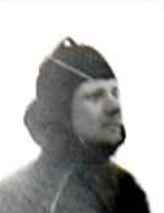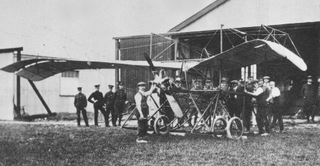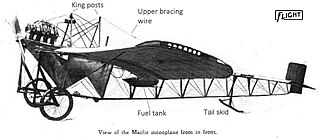
Orville Wright and Wilbur Wright, together known as the Wright brothers, were American aviation pioneers generally credited with inventing, building, and flying the world's first successful motor-operated airplane. They made the first controlled, sustained flight of a powered, heavier-than-air aircraft with the Wright Flyer on December 17, 1903, 4 mi (6 km) south of Kitty Hawk, North Carolina, at what is now known as Kill Devil Hills. The brothers were also the first to invent aircraft controls that made fixed-wing powered flight possible.

An aileron is a hinged flight control surface usually forming part of the trailing edge of each wing of a fixed-wing aircraft. Ailerons are used in pairs to control the aircraft in roll, which normally results in a change in flight path due to the tilting of the lift vector. Movement around this axis is called 'rolling' or 'banking'.

Glenn Hammond Curtiss was an American aviation and motorcycling pioneer, and a founder of the U.S. aircraft industry. He began his career as a bicycle racer and builder before moving on to motorcycles. As early as 1904, he began to manufacture engines for airships. In 1908, Curtiss joined the Aerial Experiment Association, a pioneering research group, founded by Alexander Graham Bell at Beinn Bhreagh, Nova Scotia, to build flying machines.

Aircraft flight control surfaces are aerodynamic devices allowing a pilot to adjust and control the aircraft's flight attitude.
The White Wing was an early US aircraft designed by Frederick W. Baldwin and built by the Aerial Experiment Association in 1908. Unusual for aircraft of its day, it featured a wheeled undercarriage. The wings were equipped with ailerons controlled by a harness worn around the pilot's body; leaning in one direction would cause the aircraft to bank to follow. The ailerons led to a legal dispute with the Wright brothers over the brothers' patent on movable wing surfaces.

The June Bug was an American "pioneer era" aircraft designed and flown by Glenn H. Curtiss and built by the Aerial Experiment Association (A.E.A) in 1908. The June Bug is famous for winning the first aeronautical prize ever awarded in the United States, the Scientific American Cup.

The Wright Flyer made the first sustained flight by a manned heavier-than-air powered and controlled aircraft—an airplane—on 17 December 1903. Invented and flown by Orville and Wilbur Wright, it marked the beginning of the pioneer era of aviation.
Taras Kiceniuk Jr. is a hang glider pioneer from southern California.

The Loening S-1 Flying Yacht, also called the Loening Model 23, was an early light monoplane flying boat designed in the United States by Grover Loening in the early 1920s. The aircraft won the 1921 Collier Trophy.

The Bréguet Type I was an experimental aircraft built in France in 1909. It was Louis Bréguet's first fixed-wing aircraft design. Bréguet had previously had some success with two helicopter designs, one of which had been exhibited at the Paris Aero Salon in December 1908. Because of these machines, the Type I was at first known as the Bréguet Type III.
The Lakes Water Bird, sometimes known as the Avro Curtiss-type is remembered as the first consistently successful British seaplane, developed by the Windermere-based Lakes Flying Co, during 1911.

The Bristol Type 148 was a two-seat, single-engine low-wing monoplane built in 1937 to an Air Ministry specification for an army cooperation aircraft. It lost in the competition to the Westland Lysander and did not progress past the two prototypes that were built.

The Handley Page Type D or H.P.4 was a single-seat, single-engined tractor monoplane, the first Handley Page design to fly for more than a few hops. Only one was built.

Alexander (Sandor) L. Pfitzner was a Hungarian engineer, inventor and aviation pioneer. After studying at the Hungarian University of Technology and serving in the Hungarian Army as an artillery officer, he emigrated to the United States, where he pursued a career as a designer of automobile and aircraft engines. He designed and flew the first American monoplane, the Pfitzner Flyer. Apparently depressed by its lack of success, he is reported to have committed suicide in July, 1910, although his body was never found. Following his death, reports spread that some of his friends had sighted him in New York City.

The Dunne D.7 was one of J. W. Dunne's swept wing tailless aircraft designed to have automatic stability, first flying in 1911. It was a single seat, single engined pusher monoplane developed from the unsuccessful D.6.

The Macfie monoplane was a British shoulder wing, tractor monoplane. The aircraft was powered by a 35 hp (26 kW) J.A.P. V8 engine fixed at the front of an open-frame 'fuselage', at the rear end of which a tailplane and vertical rudder were mounted.

The Handasyde glider was a single-seat monoplane glider, designed specifically for the first British gliding competition held at Itford Hill in 1922, an endurance event. It finished in second place to a French tandem-wing machine.
The Aerial Wheel Monoplane was an experimental British aircraft built during 1912 in order to compete in the Military Aeroplane Competition which was to be held at Larkhill on Salisbury Plain in August of that year. It was not assembled in time, and the aircraft was not allowed to enter the competition.

The Hanriot 1909 monoplane was an early French aircraft constructed by Rene Hanriot, a successful automobile racer.

The 1910 Deperdussin monoplane, is a general term for a variety of Deperdussin aircraft models built between 1910 and 1911. Initially released in August 1910, it was the first aircraft to be built in significant quantities by Aéroplanes Deperdussin. Many variations of the aircraft were produced, differing in size, engine type and horsepower and tail configuration. These were loosely labelled as the "Deperdussin monoplane", but were sometimes more specifically classified either by function or by seating-type. A number of Deperdussin monoplanes were flown successfully in air races and gained several speed and endurance records during 1911–1912. Several have survived, including an airworthy example in the Shuttleworth Collection in England.


















